California is a popular destination for people wanting a warm, beach getaway. Whether you’re a local or visiting the Golden State on vacation, it’s essential to know what type of weather to expect.
Now, this coastal state is no stranger to beautiful, sunny, steamy days all year long. In fact, rain in California is relatively rare. Downtown Los Angeles gets around 36 days of rain in a calendar year.
The national average is around 32 inches of rainfall per year. California sees around six inches every 12 months. Instead, the state has a plethora of deserts that thrive in the dry atmosphere on the West Coast.
Today, we’ll look at the hottest place in California, Death Valley. With temperatures exceeding 130 degrees Fahrenheit, it’s worth learning about! It is, after all, one of the hottest places on Earth!
History of Death Valley

The basin floor has white salt deposits; snaking crystal formations form hexagonal shapes in the distance.
©iStock.com/DGHayes
It’s mind-boggling to imagine anyone trying to live in such a warm environment. At least four indigenous tribes were able to coexist in this area as recently as 10,000 years ago. There used to be small lakes in this area circa 7,000 BC, and the Navarres Spring People roamed both here and in the nearby Panamint Valley.
The hunter-gatherer cultures of the Mesquite Flat People and Saratoga Spring People became more developed and were able to endure the rising temperature that the area we now know as Death Valley.
The migratory Panamint tribe survived there about 1,000 years ago. They would eat wild animals, beans, and pinyon pine nuts that would grow around the mountain slopes and in the valleys.
Many people came here during the Death Valley mining boom at the beginning of the 20th century. Their impact is still present today as a collection of Ghost Towns that can be visited. The most well-known is Panamint City, which was once Chloride City, the shortest-lived and strongest of the group, and where several stamp mills and an old burial still stand.
The largest of these abandoned communities was Rhyolite, which featured a functioning stock exchange, a bottle house, over 12 stores, 50 bars, and a train depot all those years ago. The strange narrative of Scotty’s Castel, a Spanish-style palatial palace built in the 1920s in the midst of the arid terrain, is essential to understanding Death Valley National Park’s unique history.
People can visit the castle and take a tour to learn more about the myths, deceptions, and stories that accompany this amazing paradise in the barren landscape.
Weather in Death Valley
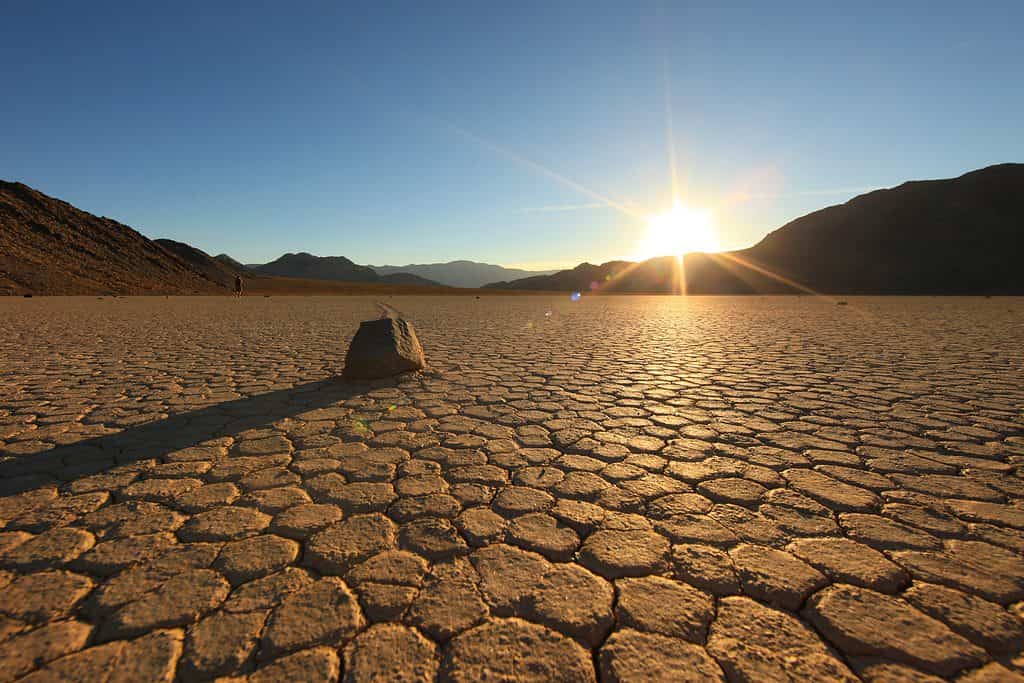
Death Valley rarely sees rain.
©Katrina Brown/Shutterstock.com
It’s common knowledge that Death Valley is hot! But just how hot is it? Death Valley’s record-breaking high air temperature was 134°F on July 10, 1913. Five days in a row saw temperatures of 129° F or higher throughout the heat wave that culminated with the record-setting temperature.
The world’s record for the hottest location on earth belongs to Death Valley. Interestingly, 1913 also happened to be the coldest year on record for Death Valley. The temperature plummeted to 15°F on January 8!
The summer months of 2001 had the most occurrences with a high temperature of 100° F or higher with 154 days. There were 105 days exceeding 110° F and 40 days above 120° F in the summer of 1996.
There were 43 days in a row in 1917’s summer when the high was 120 degrees Fahrenheit or higher. On July 15, 1972, 201° F was the hottest ground temperature ever recorded. It was near Furnace Creek. The highest air temperature on that particular day was 128 degrees Fahrenheit.
The People of Death Valley

The first inhabitants of the Death Valley area were the Timbisha Shoshone.
©Virrage Images/Shutterstock.com
After learning about just how hot this area can get, one might assume that humans cannot survive there. The first inhabitants of what is currently referred to as Death Valley were the Timbisha Shoshone. The tribe has lived in the region for many centuries and is still present.
These individuals still have a conventional lifestyle that involves hunting and foraging for sustenance since they have adjusted to Death Valley’s unforgiving climate. They take an active role in defending and conserving their ancestral homelands as well as the history and culture of the tribe.
The perseverance and resiliency of the human spirit are represented by the Timbisha Shoshone. They continue to exist and flourish in this isolated desert setting, albeit their existence in what can be among the toughest environments on earth.
Currently, there are roughly 60 people from the tribe who still reside in the Death Valley region. Death Valley’s score is 93.6 points above the national average, so residing there can be quite acceptable. Certain necessities, nevertheless, are pricey.
Fuel and food can be expensive because it can be challenging and unsafe to get items to the area. Additionally, since there are no supermarkets or shopping malls within Death Valley, getting to the nearby towns involves some travel expenses.
Wildlife in Death Valley
The phrase “Death Valley” might conjure up images of a desolate terrain. Basins below sea level receive a maximum of two inches of rain annually and are wracked by extreme temperatures and drought.
While to humans these circumstances may appear cruel, Death Valley is host to a wide variety of fauna. Many desert animals are able to drink less water since it can be challenging to find environments with fresh water throughout Death Valley.
Bighorn Sheep

These animals are common in the deserts of California.
©Frank Fichtmueller/Shutterstock.com
Bighorn sheep can endure many days without drinking but can dehydrate to the point of losing up to one-third of their body weight while wandering over mountains and valleys. They are able to consume multiple liters at once to rehydrate when water is once more accessible.
Desert Tortoise
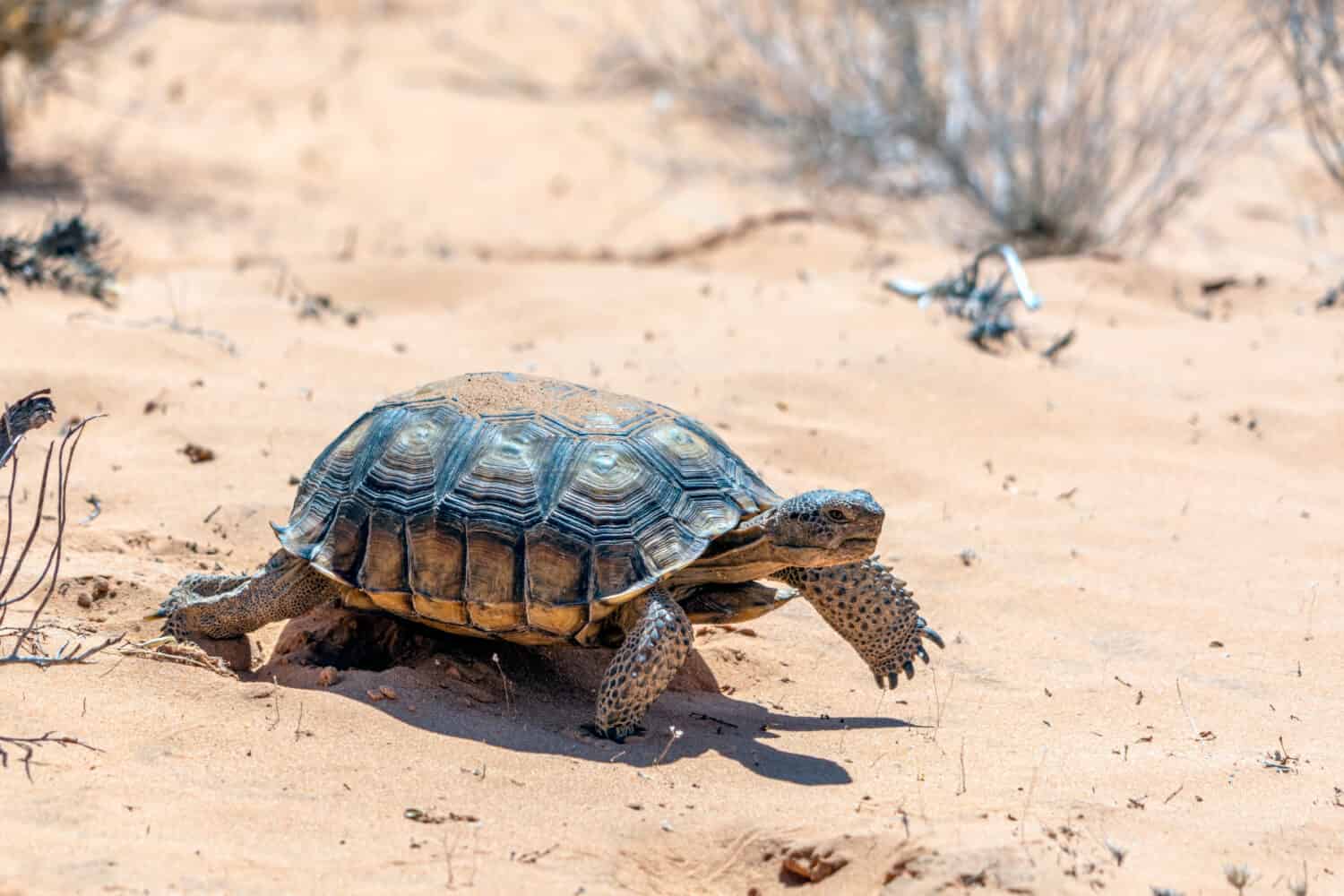
These animals spend the majority of their time in a hibernation den.
©Gchapel/Shutterstock.com
While getting enough water can be difficult, desert dwellers also have to deal with the extreme temperatures of summer. The desert tortoise is an expert at escaping the scorching sun rays. This animal spends most of the time in a tunnel because it cannot control its own body temperature.
It is shielded from severe weather in a burrow. Tortoises estivate throughout the hottest months of the year, going into a condition of inactivity that enables them to preserve both energy and water.
Furthermore, desert tortoises burrow in order to endure the chilly winter months. Desert tortoises may only spend a few months above ground, subject to the climate.
Kangaroo Rats
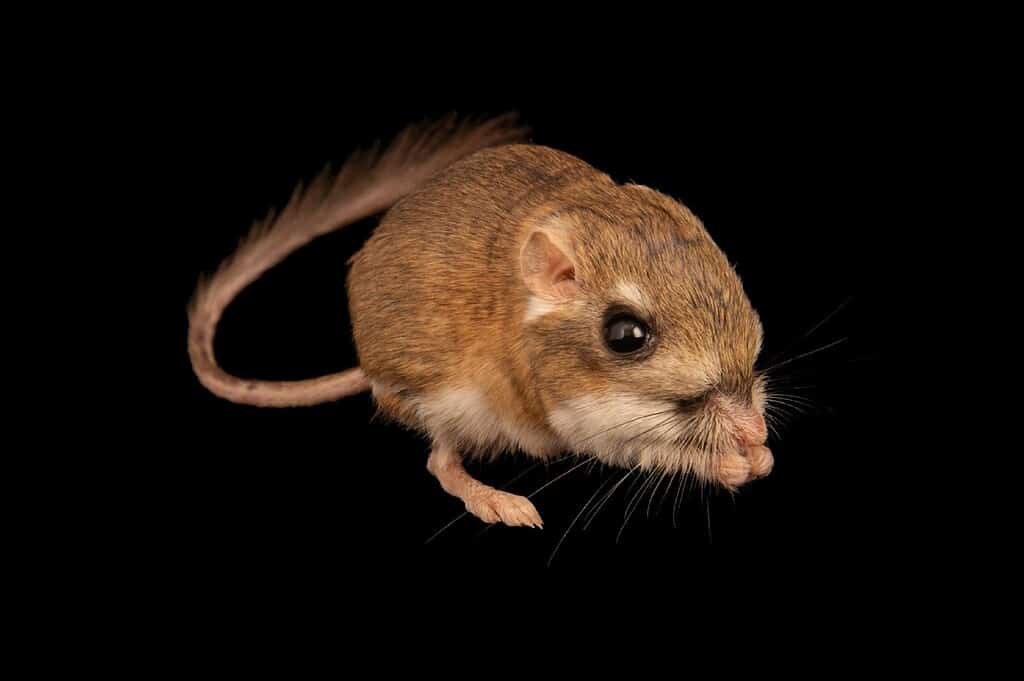
Dehydration is of no concern to kangaroo rats.
©Usha Roy/Shutterstock.com
Kangaroo rats lack the need to be concerned about dehydration, just like bighorn sheep. They are actually born with an innate ability to survive in arid regions, thus they seldom need to consume fluids.
Water that has been ingested from the food they eat, which is enough to sustain them. Kangaroo rats get rid of waste in exceptionally concentrated urine as well as dry feces, conserving their body’s valuable water.
Jackrabbit
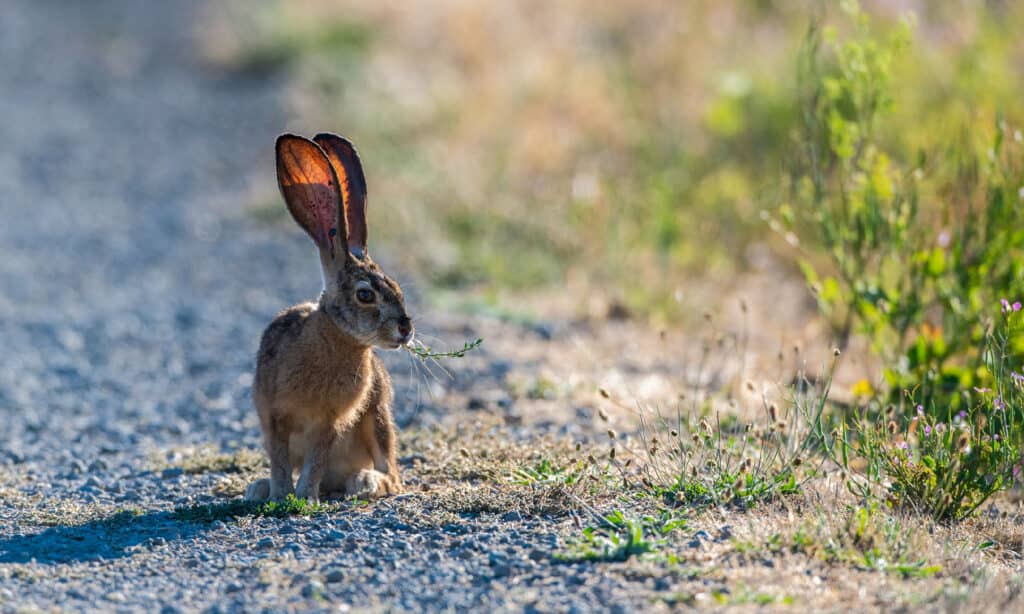
The large ears of a jackrabbit allow the animal to expel heat and regulate temperature.
©iStock.com/zhuclear
Another typical desert animal, the jackrabbit, regulates its body temperature by expelling heat through its large ears. Warm blood from the rabbit’s center flows via blood vessels in its ears while it hides in the shade, dispersing body heat into the atmosphere.
Although surviving in the desert is difficult, all of the creatures that call Death Valley home have figured out how to live long and prosper. Obtaining food, water, and remaining temperate are daily obstacles that they adapt to help them to survive and thrive.
Coyotes

A lone coyote lays down at Bad Water in Death Valley National Park.
©iStock.com/dmodlin01
It is hardly surprising that coyotes are a frequent appearance at Death Valley National Park given that they are among the most omnipresent and resilient mammals in North America. Coyotes are extremely bright and adaptable animals that can be encountered all over the park. Although coyotes tend to be active in the early hours of the day, they are frequently heard wailing at night.
Mule Deer
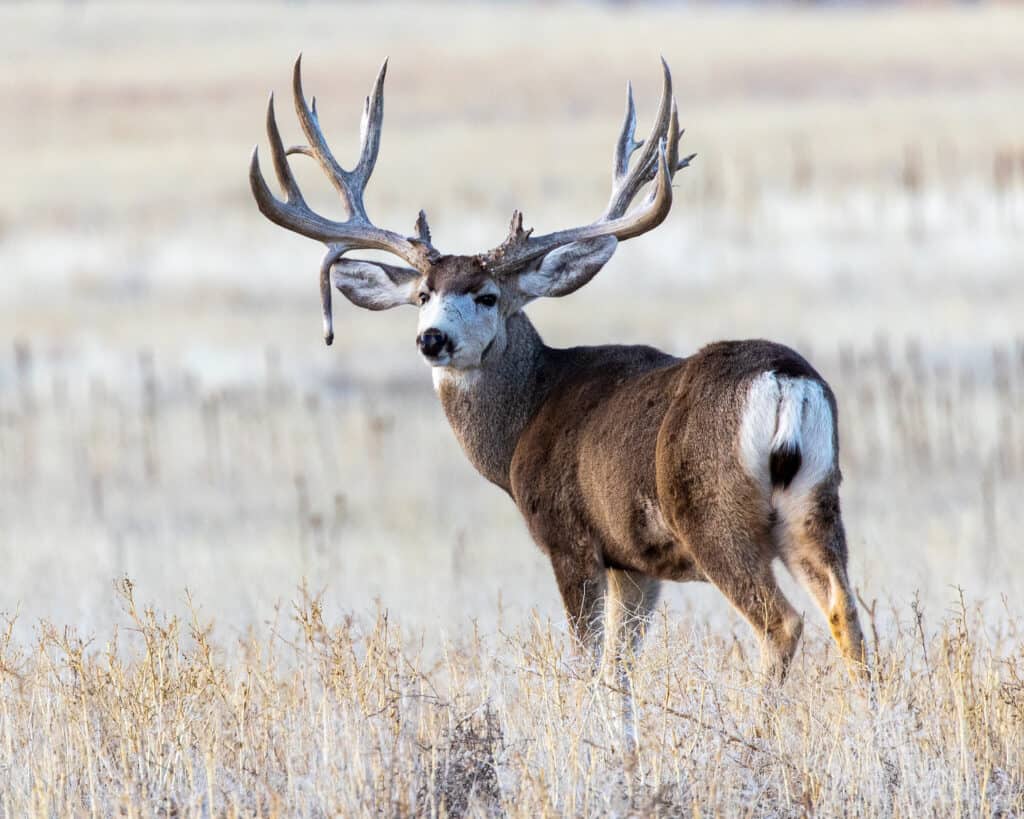
The velvet on this animal has a primary function to supply the cartilage with oxygen and required nutrients.
©iStock.com/Jeff Edwards
In Death Valley National Park’s upper altitudes, in which there are greater amounts of vegetation and water sources, you can frequently see mule deer. These majestically enormous animals got their name from their enormous ears, which look like mule ears.
In the area around Furnace Creek, mule deer have been observed especially in the wee hours of the morning or late afternoon while they are at their most active. Deer are occasionally sighted around Scotty’s Castle, where they can be viewed crossing the street or feeding in the surrounding fields.
The photo featured at the top of this post is © Dan Sedran/Shutterstock.com
Thank you for reading! Have some feedback for us? Contact the AZ Animals editorial team.







